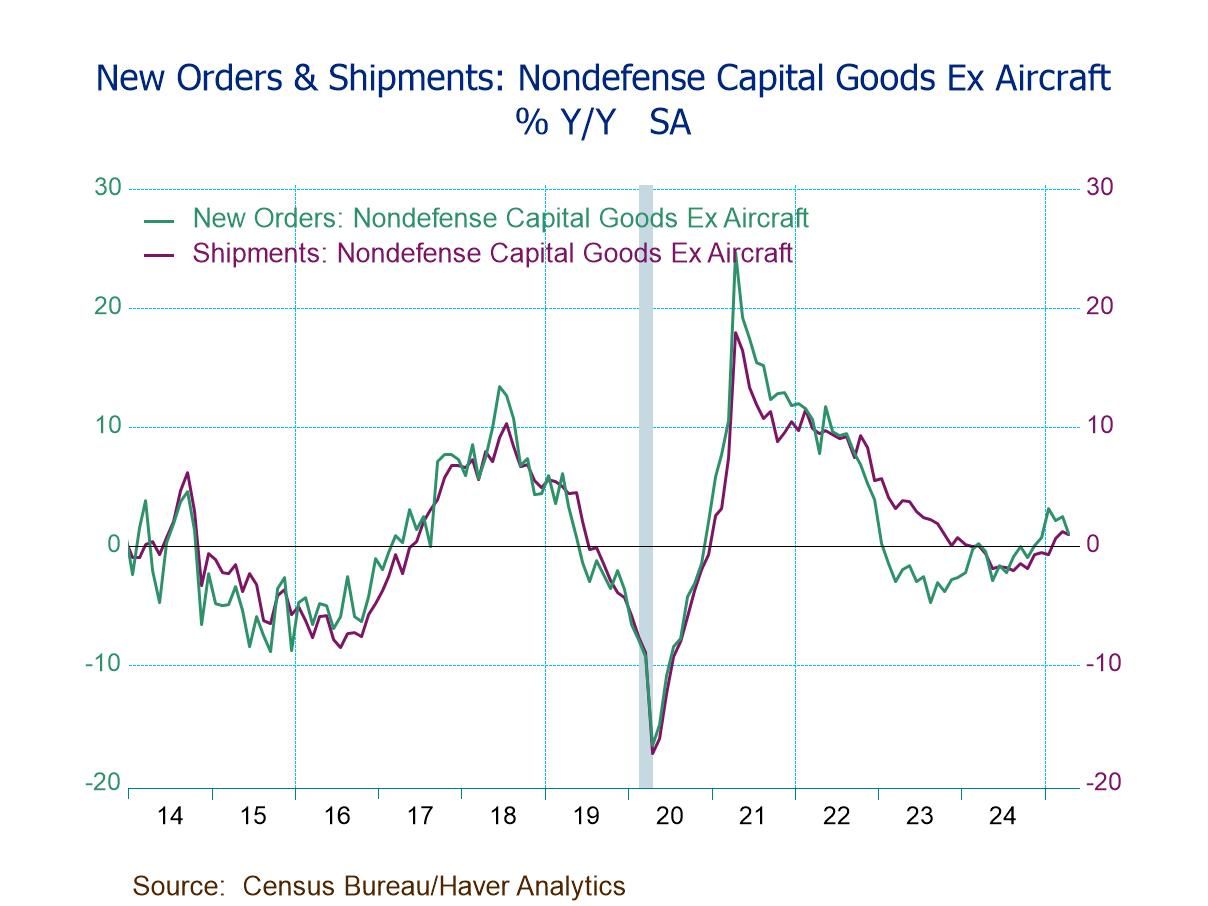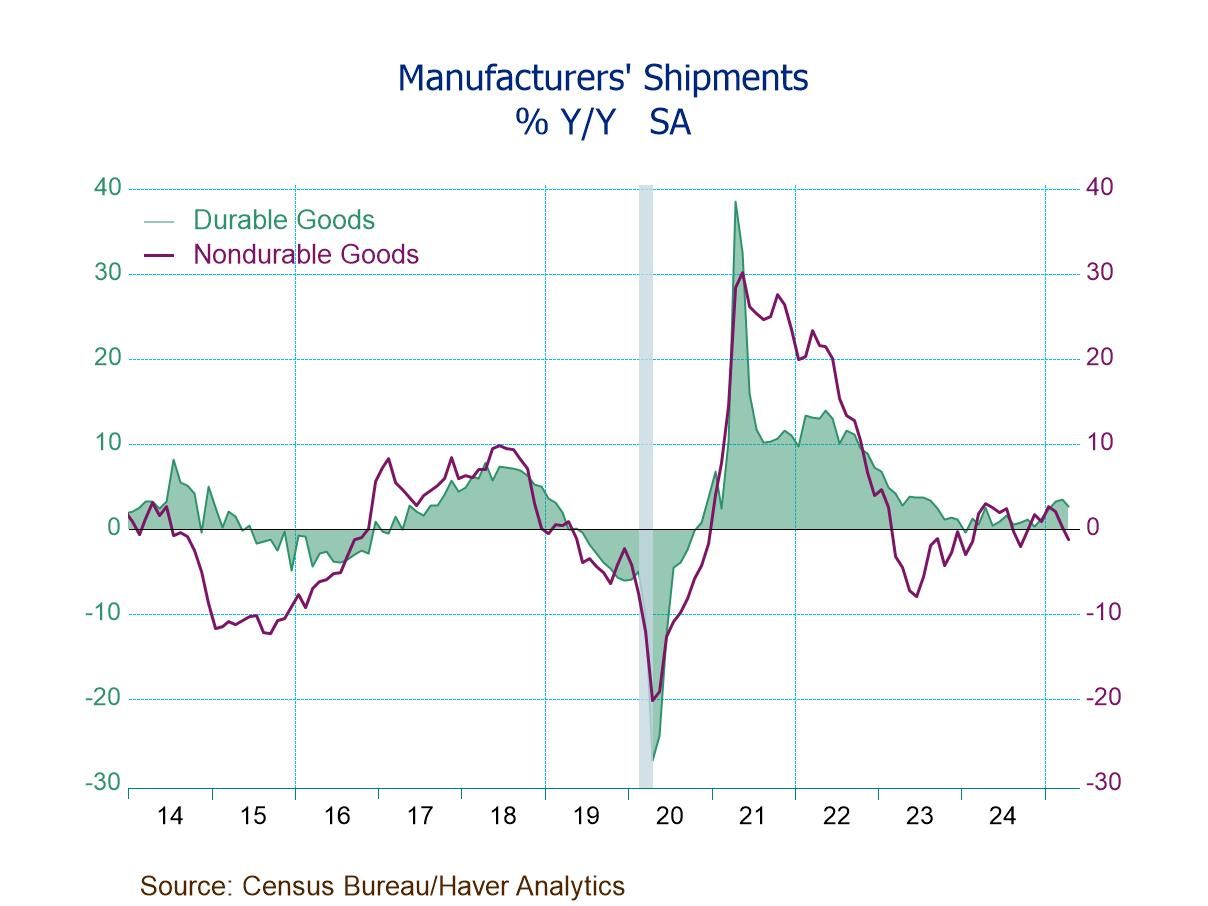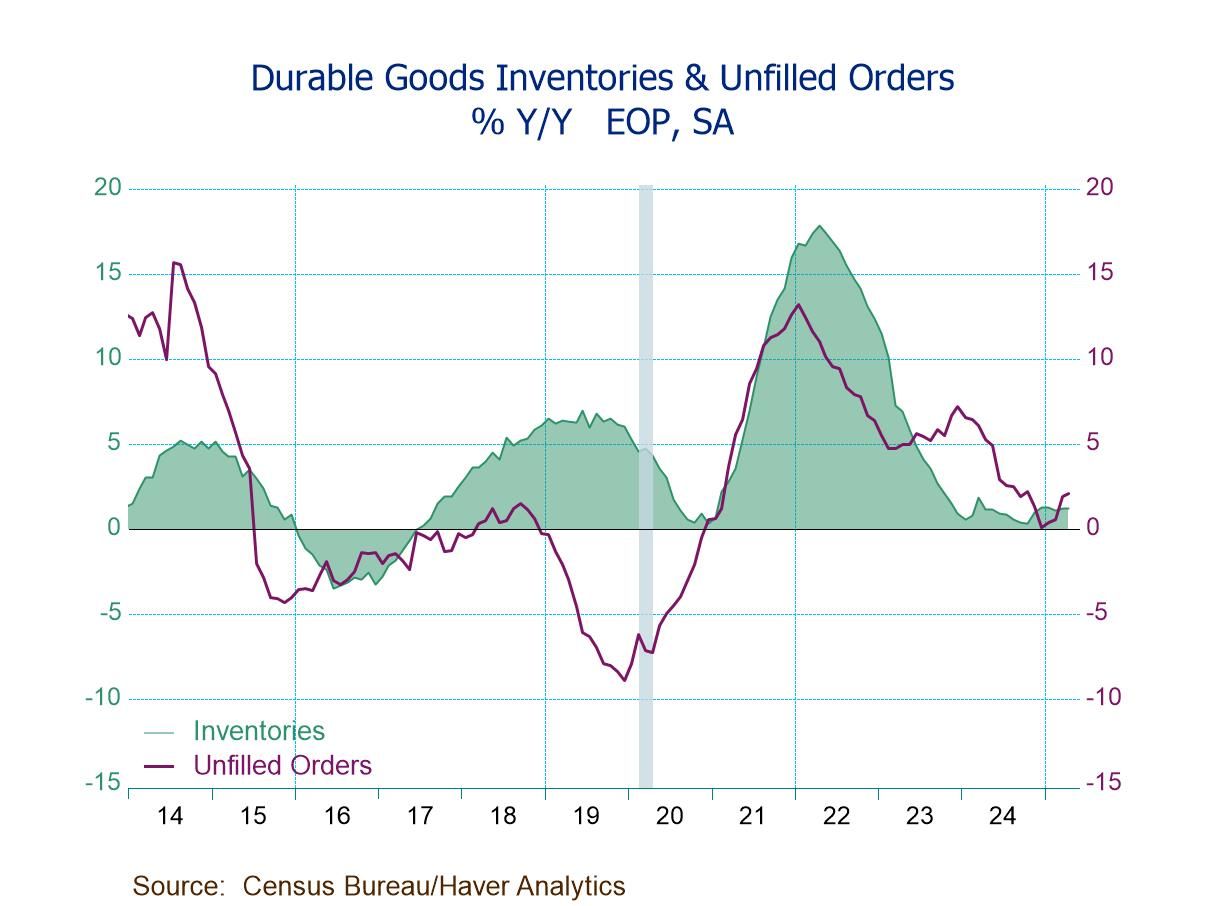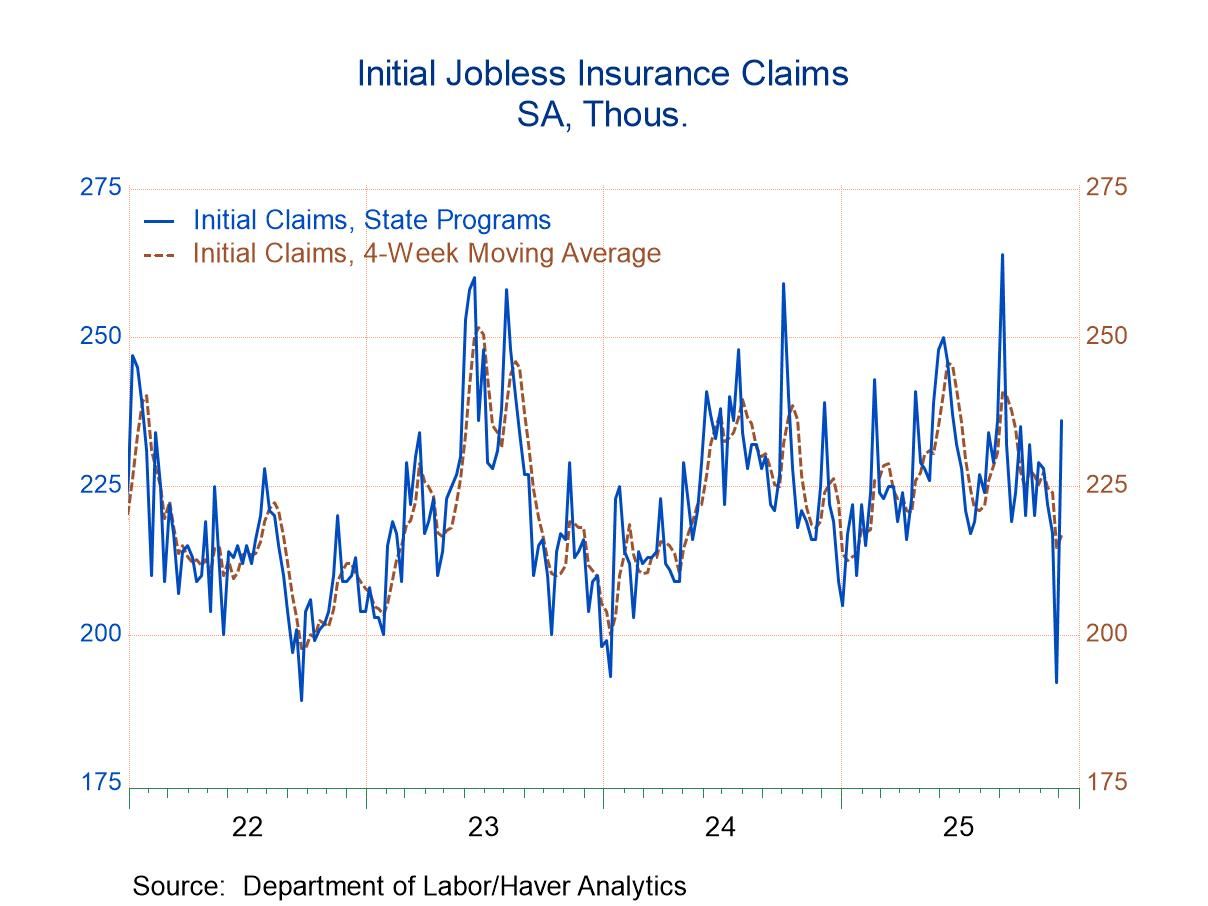U.S. Durable Goods Orders Fall in April, the First M/M Drop Since November
Summary
- Headline: -6.3% (+3.2% y/y) in April vs. +7.6% (+10.0% y/y) in March.
- Nondefense aircraft orders plunge 51.5% m/m vs. a 158.5% March surge.
- Transportation orders slump 17.1% m/m; excluding transportation, orders rebound 0.2% m/m.
- Core capital goods shipments dip 0.1%, the first m/m easing since October.
- Durable goods shipments +0.4% m/m, unfilled orders unchanged, and inventories +0.1% m/m.


New orders for durable goods fell a less-than-expected 6.3% m/m in April after a 7.6% rise in March (+9.2% initially reported on Apr. 24), according to today’s advance report by the U.S. Census Bureau. The Action Economics Forecast Survey had expected a 7.9% m/m April drop. The April reading was the first m/m fall since November and the deepest since January 2024. The year-on-year rate decelerated to 3.2% in April from 10.0% in March, registering the lowest y/y pace since a 4.5% y/y decrease in December. Durable goods orders excluding the transportation sector grew 0.2% (1.9% y/y), the fourth m/m increase in five months, reversing a 0.2% March decline. Durable goods orders excluding defense fell 7.5% (+2.8% y/y) in April, the first m/m fall in five months, after a 9.0% advance in March.
The m/m fall in April durable goods orders was led by a 51.5% m/m plunge in orders for nondefense aircraft & parts following a 158.5% surge in March and a 10.2% decrease in February. Orders for defense aircraft & parts slid 5.3% (+11.3% y/y) in April, the third m/m slide in four months, on top of a 16.1% decrease in March. Orders excluding aircraft were down 0.2% (+1.0% y/y), the first m/m decline in three months, following a 0.1% March uptick.
Durable goods orders for transportation plunged 17.1% (+6.1% y/y) in April, the first m/m decline since November and the deepest since January 2024, following a 23.5% jump in March. Orders for motor vehicles & parts fell 2.9% (-3.1% y/y) in April after a 1.6% rise in March and orders for all other durable goods fell 0.8% (0.0% y/y) following a 0.5% March increase; both posted the first m/m drop since January. Orders for electrical equipment, appliances & components slid 0.2% (+5.9% y/y) in April, the third m/m slide in four months, after a 0.9% decline in March. Orders for primary metals edged down 0.1% (-0.3% y/y), the first m/m easing since December, following a 0.7% March increase. To the upside, the following durable goods orders rose m/m in April: computers & electronic products (1.0%; 2.9% y/y), fabricated metal products (0.8%; 2.5% y/y), and machinery (0.8%; 2.8% y/y).
Capital goods orders dropped 14.6% (+8.3% y/y) in April, the deepest m/m decline since January 2024, after having recovered 21.7% in March. Nondefense capital goods orders decreased 19.1% (+7.9% y/y), also the deepest since January 2024, following a 27.2% March rebound. Core capital goods orders (i.e., nondefense capital goods orders excluding aircraft) fell 1.3% (+1.0% y/y), down for the second month in three, after a 0.3% March increase. Defense capital goods orders surged 30.5% (10.6% y/y), the first m/m gain since December and the most since October 2023, reversing a 15.0% March drop. Notably, core capital goods shipments (core capex shipments), a reliable coincident indicator of business spending on equipment in the national accounts, slipped 0.1% (+0.9% y/y) in April, the first m/m decline since October, following a 0.5% increase in March.
Shipments of all manufactured goods fell 0.3% (+0.6% y/y) in April after a 0.2% decline in March and four consecutive m/m increases. Durable goods shipments grew 0.4% (2.6% y/y), the fifth straight m/m gain, on top of a 0.2% March increase. Nondurable goods shipments fell 0.9% (-1.3% y/y) following a 0.7% March decline and two successive m/m increases.
Unfilled orders of durable goods were virtually changed m/m (2.1% y/y) in April after rising 1.6% in March and holding steady in February and January. Excluding transportation, unfilled orders dipped 0.1% (+0.6% y/y) in April after a 0.2% decline in March and no change in February.
Manufacturing inventories ticked down 0.1% (+0.8% y/y) in April following three consecutive 0.1% increases. Durable goods inventories edged up 0.1% (1.2% y/y) in April and March after holding steady in February and January. Nondurable goods inventories fell 0.4% (+0.2% y/y) in April after a 0.1% March uptick and three straight 0.2% gains.
Manufacturers’ orders and shipments of durable and nondurable goods, along with unfilled orders and inventories, are compiled by the U.S. Census Bureau. They are available in Haver’s USECON database. The Action Economics forecast data are in the AS1REPNA database.


Winnie Tapasanun
AuthorMore in Author Profile »Winnie Tapasanun has been working for Haver Analytics since 2013. She has 20+ years of working in the financial services industry. As Vice President and Economic Analyst at Globicus International, Inc., a New York-based company specializing in macroeconomics and financial markets, Winnie oversaw the company’s business operations, managed financial and economic data, and wrote daily reports on macroeconomics and financial markets. Prior to working at Globicus, she was Investment Promotion Officer at the New York Office of the Thailand Board of Investment (BOI) where she wrote monthly reports on the U.S. economic outlook, wrote reports on the outlook of key U.S. industries, and assisted investors on doing business and investment in Thailand. Prior to joining the BOI, she was Adjunct Professor teaching International Political Economy/International Relations at the City College of New York. Prior to her teaching experience at the CCNY, Winnie successfully completed internships at the United Nations. Winnie holds an MA Degree from Long Island University, New York. She also did graduate studies at Columbia University in the City of New York and doctoral requirements at the Graduate Center of the City University of New York. Her areas of specialization are international political economy, macroeconomics, financial markets, political economy, international relations, and business development/business strategy. Her regional specialization includes, but not limited to, Southeast Asia and East Asia. Winnie is bilingual in English and Thai with competency in French. She loves to travel (~30 countries) to better understand each country’s unique economy, fascinating culture and people as well as the global economy as a whole.





 Global
Global
